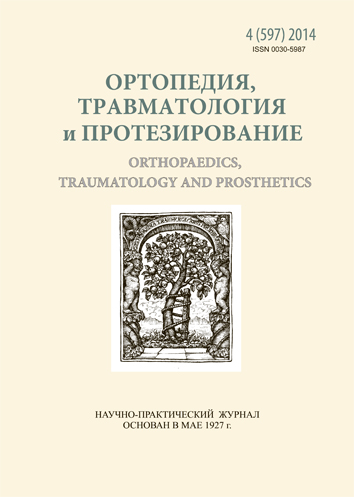Prevention of posttraumatic adhesions around the Achilles tendons in rabbits
DOI:
https://doi.org/10.15674/0030-59872014456-64Keywords:
Achilles tendon, experiment, traumatic injury, rehabilitation, medications, adhesionsAbstract
The problem of treatment of tendon injuries remains unresolved despite on the variety of ways for its restoration. Unsatisfactory outcomes after surgical treatment according to different authors range from 15 to 62 %. The most important problem of tendon surgery is restoration of its function of sliding. Objective: To study the structural organization of the injured tendon by implementation of medications around tendon suture. Methods: The experiments were performed on 12 mongrel rabbits aged 12–18 months, weight 1 850–2 000 g. Partial Achilles tendon injury was modeled after cutting it at 1/2 diameter. In the control group (1st series) stitches were not treated. In experimental animals we injected around the tendon suture in the 2nd series — 1 ml 1 % hyaluronic acid (Syngial™), 3rd series — 1 ml of 4.5 % three-dimensional polyacrylamide polymer (Noltrex™), 4th series — 1 ml 64 IU hyaluronidase/ml (Lidasa-Biolik™). The study was conducted by means of light and polarization microscopy. Results: after 60 days in the area of traumatic injury tendon-like tissue that contained diverse bundles of collagen fibers made of collagen types I and III formed. Maximum accumulation of collagen type III was detected in regenerates of the animals in 1 and 4 series. Destructive tendon disorders in the areas located above or below of the injury zone found in all series of experiments: the most pronounced in the 4 (II stage), less pronounced — in 2 and 3 (I stage). The growth of connective tissue that violates sliding of bundles of collagen fibers was the most pronounced in the 1st and 4th series of experiments. Conclusion: For restoration of sliding function of the tendon and for prevention of tendon adhesions can be recommended medications Syngial™ and Noltrex™.
References
- Junqueir a L. C. Differential staining of collagens type I, II and III by Sirius Red and polarization microscopy / L. C. Junqueir a, W. Cossermelli , R. Bren tani ni // Arc h. His tol . Jpn. — 1978. — Vol . 41. — Р. 267–274.
- Movin and Bon ar scores assess the same characteristics of tendon histology / N. Maff ff ulli , U. G. Longo , C. Rabitti [et al.] // Clin . Orthop. Rel at. Res . — 2008. — Vol . 466. — P. 1605–1611, doi : 10.1007/s11999-008-0261-0.
- Immunolocalization of collagens (I and III) and cartilage oligomeric matrix protein in the normal and injured red equine superficial digital flexor tendon / F. Söders ten , K. Hulten by, D. Heineg ård [et al.] // Connec t. Tiss ue Res . — 2013. — Vol . 54, № 1 —
- Р. 62–69, doi : 10.3109/03008207.2012.734879.
Downloads
How to Cite
Issue
Section
License
Copyright (c) 2014 Alexander Khvysyuk, Basil Pastukh, Ninel Diedukh

This work is licensed under a Creative Commons Attribution 4.0 International License.
The authors retain the right of authorship of their manuscript and pass the journal the right of the first publication of this article, which automatically become available from the date of publication under the terms of Creative Commons Attribution License, which allows others to freely distribute the published manuscript with mandatory linking to authors of the original research and the first publication of this one in this journal.
Authors have the right to enter into a separate supplemental agreement on the additional non-exclusive distribution of manuscript in the form in which it was published by the journal (i.e. to put work in electronic storage of an institution or publish as a part of the book) while maintaining the reference to the first publication of the manuscript in this journal.
The editorial policy of the journal allows authors and encourages manuscript accommodation online (i.e. in storage of an institution or on the personal websites) as before submission of the manuscript to the editorial office, and during its editorial processing because it contributes to productive scientific discussion and positively affects the efficiency and dynamics of the published manuscript citation (see The Effect of Open Access).














